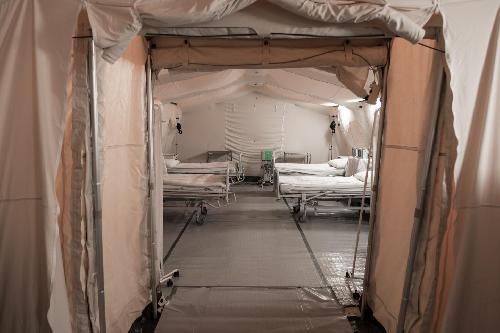Leaders of the Syrian-American Medical Society describe their efforts in bolstering what remains of the Syrian healthcare system and the health care context in which those efforts take place in their article, "War is the Enemy of Health: Pulmonary, Critical Care and Sleep Medicine in War-torn Syria." The article is published online ahead of print in the American Thoracic Society journal Annals of the American Thoracic Society.
The Syrian-American Medical Society was formed shortly after the war began to help Syrian refugees in Turkey. Since then, it has grown into a $25-million enterprise that has helped more than two million people, according to lead author Mohammed Z. Sahloul, MD, a pulmonologist and critical care physician in Oak Lawn, IL, who served as its president for four years.
The Society provides 24/7 telemedicine consulting to nine Syrian ICUs. It has conducted 17 "train-the-trainer" webinars for 850 doctors, nurses, paramedics and technicians on such topics as how to resuscitate trauma patients, the fundamentals of critical care and triaging surgery patients. And in classrooms in Turkey and Lebanon, it has trained Syrian doctors in the use of, and equipped them with, portable ultrasound to diagnose bodily injuries. Powered by rechargeable batteries, this technology has proved especially helpful in the war-torn region prone to power outages.
 This is a field hospital. Credit: ATS
This is a field hospital. Credit: ATS
By all accounts, the health care situation in Syria is grim. The authors cite statistics that they and other organizations have compiled:
- In the first four years of the conflict, 75,000 civilians died from war injuries; 25 percent of those killed were women and children.
- More than twice that number have died from chronic and infectious disease because of inadequate medical care.
There is growing incidence of TB among Syrian refugees in Lebanon. 2014 British Medical Journal article found a 27 percent increase in TB.
- By 2013, 70 percent of the health care workforce had left the country. In Syria's largest city, Aleppo, only 70 of the 6,000 physicians who once practiced there remain.
- Syrian life expectancy has plummeted by 20 years since war broke out.
Responding to this health care crisis has been made much more difficult by the targeting of hospitals and health care workers, primarily by the government but also by the rebels, according to the authors.
"The Syrian conflict is unprecedented in the scale and gravity of the attacks on medical neutrality, which was something that was agreed upon 150 years ago in Geneva," Dr. Sahloul said. "Nearly 700 medical workers have been killed in this war, and more than 300 hospitals attacked, according to Physicians for Human Rights."
Dr. Sahloul decried the absence of a forceful response to these war crimes by physicians and international medical organizations. Medical neutrality, which is designed to protect civilians and the health care professionals who treat them during a war, is something "sacred among medical professionals," he added.
"The medical community is very late in responding to the situation in Syria," Dr. Sahloul said. "As physicians, we not only have an obligation, we have a powerful voice to insist that policy makers ensure that populations under siege have access to care."
The Syrian-American Medical Society has also documented the use of chemical weapons, another war crime, by the Syrian armed forces. Since December 2012, the group reports that there have been 152 attacks using toxic gases, including 8 using sarin, which paralyzes respiratory muscles, and 92 with chlorine gas, which dissolves lung tissue.
Dr. Sahloul said that most people have only heard of the 2013 sarin attack that killed 1,400 people and injured 10,000 others. The Syrian-American Medical Society has trained Syrian health care workers in how to treat patients exposed to chemical agents.
Despite the makeshift conditions under which medical care is provided in Syria, the authors argue that the efforts of the Syrian-American Medical Society and other groups supporting the health care workers remaining in the country should be subject to evaluation and measurement. "A retrospective survey of 527 health care workers trained in portable ultrasound found that 87 percent had incorporated the technology into the daily management of violent conflict," Sahloul said. "This technology should be studied in areas of war. It has the potential to save thousands of lives."
Sahloul's observation captures the animating principle of the Syrian-American Medical Society implicit in the journal article: even in humankind's darkest moments, caring and rational people can provide light.
source: American Thoracic Society